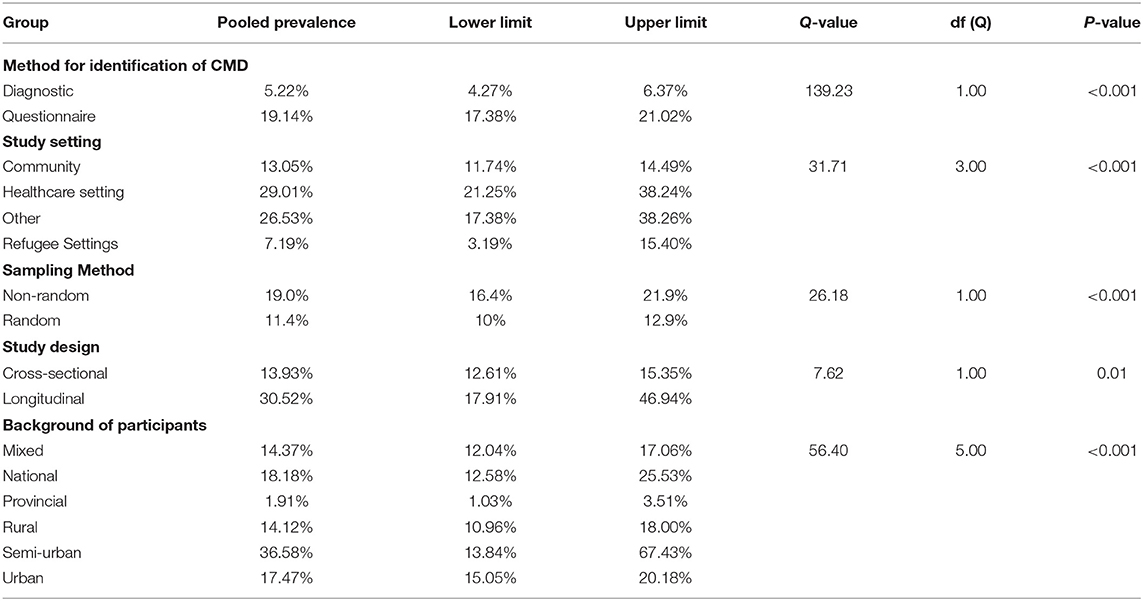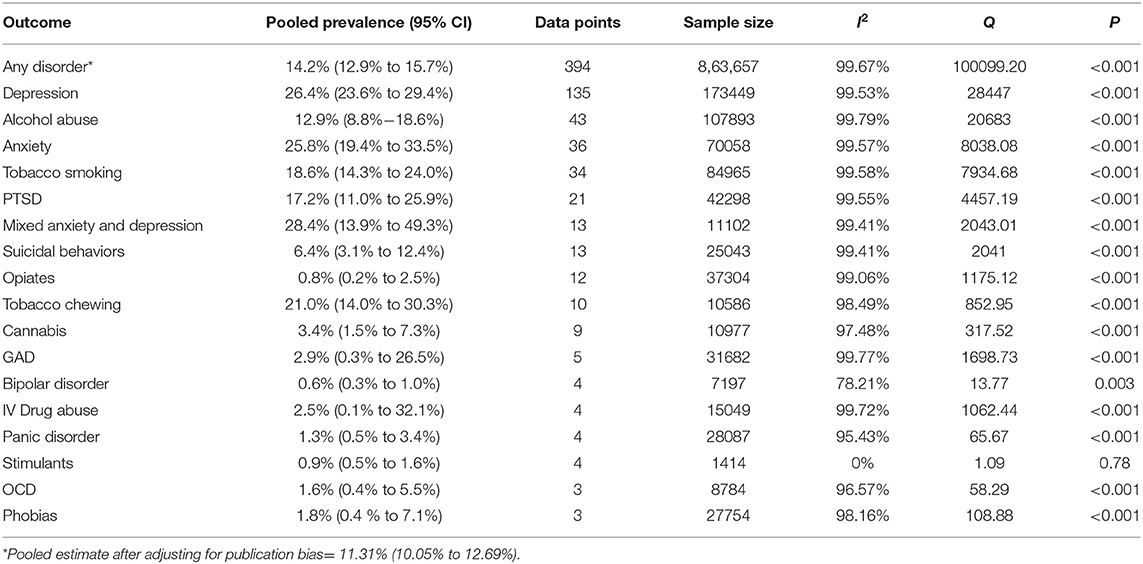- 1Department of Child Psychiatry, Kansas University Medical Center, Kansas City, KS, United States
- 2Institute of Population Health, University of Liverpool, Liverpool, United Kingdom
- 3Nishtar Medical University, Multan, Pakistan
- 4Dow Medical College, Karachi, Pakistan
- 5FMH College of Medicine and Dentistry, Lahore, Pakistan
- 6King Edward Medical University, Lahore, Pakistan
- 7Fatima Jinnah Medical University, Lahore, Pakistan
A Corrigendum on
Prevalence of Common Mental Disorders in South Asia: A Systematic Review and Meta-Regression Analysis
by Naveed, S., Waqas, A., Chaudhary, A. M. D., Kumar, S., Abbas, N., Amin, R., et al. (2020). Front. Psychiatry 11:573150. doi: 10.3389/fpsyt.2020.573150
In the original article, there was a mistake in Table 1 “Pooled prevalence of mental disorders in South Asia” as published. Prevalence estimates of five of the psychiatric disorders were wrongly formatted with misplaced decimal points. The corrected Table 1 “Pooled prevalence of mental disorders in South Asia” appears below.
In the original article, there was a mistake in Table 3 “Subgroup analyses presenting several factors associated with the prevalence of CMDs in included studies” as published. Prevalence estimates for subgroups of sampling methods were wrongly formatted. The corrected Table 3 “Subgroup analyses presenting several factors associated with the prevalence of CMDs in included studies” appears below.

Table 3. “Subgroup analyses presenting several factors associated with the prevalence of CMDs in included studies”.
In the original article, there was an error. Prevalence estimates for panic disorder was wrongly formatted with misplaced decimal points in the results section of abstract and main text.
A correction has been made to the Research section, Paragraph Number 2:
We assessed the pooled prevalence for 17 different mental disorders over a period of 10 years. All the outcomes presented significant heterogeneity ranging from 0% to 99.79% for stimulant use and alcohol abuse, respectively. The prevalence of depressive symptoms was reported in 135 studies (I2 = 99.53%) yielding a prevalence of 26.4% among 173,449 participants. Alcohol abuse was reported in 43 studies yielding a prevalence of 12.9% (8.8%−18.6%, I2 = 99.79%, n = 107893); anxiety 25.8% (19.4% to 33.5%, I2 = 99.57%, n = 70,058); tobacco smoking 18.6% (14.3% to 24%, I2 = 99.58%, n = 84965); PTSD 17.2% (11% to 25.9%, I2 = 99.55%, n = 42298); mixed anxiety and depression 28.4% (13.9% to 49.3%, I2 = 99.41%, n = 11102); suicidal behaviors 6.4% (3.1% to 12.4%, I2 = 99.41%, n = 25043); misuse of opiates 0.8% (0.2% to 2.5%, I2 = 99.06%, n = 37304); tobacco chewing 21.0% (14.0% to 30.3%, I2 = 98.49%, n = 10586); use of cannabis 3.4% (1.5% to 7.3%, I2 = 97.48%, n = 10977); GAD 2.9% (0.3% to 26.5%, I2 = 99.57%, n = 70058); bipolar disorder 0.6% (0.3% to 1.0%, I2 = 78.21%, n = 7197); IV drug abuse 2.5% (0.1% to 32.1%, I2 = 99.72%, n = 15049); Panic disorder 1.3% (0.5% to 3.4%, I2 = 95.43%, n = 28087); stimulant use 0.9% (0.5% to 1.6%, I2 = 0%, n = 1414); OCD 1.6% (0.4% to 5.5%, I2 = 96.57%, n = 8784) and phobic disorders 1.8% (0.4% to 7.1%, I2 = 98.16%, n = 27754). Supplementary Figures 1–12 represent the forest plots for the above-mentioned disorders.
In the original article, there was an error. Prevalence estimates for panic disorder was wrongly formatted with misplaced decimal points in the results section of abstract and main text.
A correction has been made to the abstract:
A prevalence of depressive symptoms was 26.4% among 173,449 participants, alcohol abuse was 12.9% (n = 107,893); anxiety 25.8% (n = 70,058); tobacco smoking 18.6% (n = 84,965); PTSD 17.2% (n = 42,298); mixed anxiety and depression 28.4% (n = 11,102); suicidal behaviors 6.4% (n = 25,043); misuse of opiates 0.8% (n = 37,304); tobacco chewing 21.0% (n = 10,586); use of cannabis 3.4% (n = 10,977); GAD 2.9% (n = 70,058); bipolar disorder 0.6% (n = 7,197); IV drug abuse 2.5% (n = 15,049); panic disorder 1.3% (n = 28,087); stimulant use 0.9% (n = 1,414); OCD 1.6% (n = 8,784) and phobic disorders 1.8% (n = 27,754).
The authors apologize for these errors and state that this does not change the scientific conclusions of the article in any way. The original article has been updated.
Keywords: psychiatric illness, South Asia, prevalence, epidemiology, common mental disorders
Citation: Naveed S, Waqas A, Chaudhary AMD, Kumar S, Abbas N, Amin R, Jamil N and Saleem S (2020) Corrigendum: Prevalence of Common Mental Disorders in South Asia: A Systematic Review and Meta-Regression Analysis. Front. Psychiatry 11:602062. doi: 10.3389/fpsyt.2020.602062
Received: 02 September 2020; Accepted: 14 September 2020;
Published: 20 November 2020.
Edited and reviewed by: Wulf Rössler, Charité – Universitätsmedizin Berlin, Germany
Copyright © 2020 Naveed, Waqas, Chaudhary, Kumar, Abbas, Amin, Jamil and Saleem. This is an open-access article distributed under the terms of the Creative Commons Attribution License (CC BY). The use, distribution or reproduction in other forums is permitted, provided the original author(s) and the copyright owner(s) are credited and that the original publication in this journal is cited, in accordance with accepted academic practice. No use, distribution or reproduction is permitted which does not comply with these terms.
*Correspondence: Ahmed Waqas, YWhtZWQud2FxYXNAbGl2ZXJwb29sLmFjLnVr
 Sadiq Naveed
Sadiq Naveed Ahmed Waqas
Ahmed Waqas Amna Mohyud Din Chaudhary
Amna Mohyud Din Chaudhary Sham Kumar4
Sham Kumar4